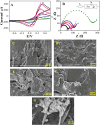A field-portable electrochemical immunosensor based on a multifunctional Ag2O/g-C3N4@MA-DBB covalent organic framework receptor interface for single-step detection of aflatoxin M1 in raw milk samples
- PMID: 39263407
- PMCID: PMC11385986
- DOI: 10.1039/d4na00327f
A field-portable electrochemical immunosensor based on a multifunctional Ag2O/g-C3N4@MA-DBB covalent organic framework receptor interface for single-step detection of aflatoxin M1 in raw milk samples
Abstract
Aflatoxin M1 (AFM1), a hydroxylated metabolite of aflatoxin B1 (AFB1), contaminates milk and dairy products from livestock via ingestion of feed contaminated with a species of Aspergillus. As AFM1 is a Group-II B carcinogen, it is indispensable to develop novel, easy-to-handle, sensitive, portable and cost-effective strategies for its detection. Herein, a covalent organic framework (COF)-based electroactive nanocomposite, Ag2O/g-C3N4-COOH@MA-DBB-COF (silver oxide/carboxy-functionalized graphitic carbon nitride@melamine-dibromo butane COF), is designed to serve as a multifunctional receptor surface. The Ag2O/g-C3N4-COOH@MA-DBB-COF formation was characterized through X-ray diffraction (XRD), Fourier transform infrared (FTIR) spectroscopy, micro-Raman spectroscopy (RAMAN), dynamic light scattering (DLS) and thermogravimetric analysis (TGA), and each step of the sensor fabrication was monitored using field emission scanning electron microscopy (FE-SEM), cyclic voltammetry (CV) and electrochemical impedance spectroscopy (EIS). Under the optimal conditions, the designed immunosensor permitted the detection of AFM1 in the linear range of 0.03-1000 fg mL-1, with a 0.01 fg mL-1 limit of detection (LOD). The selectivity of the designed immunosensor was validated via an anti-interference study. The practical applicability of the immunosensor was demonstrated by the detection of AFM1 in real milk samples, and good recovery values (97.28-102.62%) were obtained. Furthermore, the developed immunosensor and high-performance liquid chromatography (HPLC) were employed in parallel to detect AFM1 in local market milk samples from twenty different sites to validate the performance of the newly designed immunosensor. Additionally, the designed immunosensor was stable over an extended period of time. This work reports a single-step field-portable multifunctional innovative electrochemical immunoreceptor design for on-site and label-free detection of AFM1 in milk samples. Hence, the present study is the first report on the fabrication of a multifunctional innovative electrochemical immunoreceptor based on PGE/Ag2O/g-C3N4-COOH@MA-DBB-COF for the detection of AFM1 in milk samples.
This journal is © The Royal Society of Chemistry.
Conflict of interest statement
The authors declare that they have no known competing interests.
Figures




Similar articles
-
A carbon fiber modified with tin oxide/graphitic carbon nitride as an electrochemical indirect competitive immuno-sensor for ultrasensitive aflatoxin M1 detection.Bioelectrochemistry. 2025 Jun;163:108898. doi: 10.1016/j.bioelechem.2025.108898. Epub 2025 Jan 9. Bioelectrochemistry. 2025. PMID: 39799669
-
Covalent organic framework-based aptananozyme (COF@NH2 apt-AFM1): A novel platform for colorimetric and fluorescent aptasensing of AFM1 in milk.Food Chem. 2025 Aug 30;484:144478. doi: 10.1016/j.foodchem.2025.144478. Epub 2025 Apr 22. Food Chem. 2025. PMID: 40279903
-
Screen-printed electrochemical immunosensor based on a novel nanobody for analyzing aflatoxin M1 in milk.Food Chem. 2022 Jul 30;383:132598. doi: 10.1016/j.foodchem.2022.132598. Epub 2022 Mar 1. Food Chem. 2022. PMID: 35255369
-
An overview of aflatoxin B1 biotransformation and aflatoxin M1 secretion in lactating dairy cows.Anim Nutr. 2021 Mar;7(1):42-48. doi: 10.1016/j.aninu.2020.11.002. Epub 2021 Jan 5. Anim Nutr. 2021. PMID: 33997330 Free PMC article. Review.
-
Aptamers for aflatoxin M1: from aptasensing technology to commercialization.Crit Rev Food Sci Nutr. 2025 May 29:1-19. doi: 10.1080/10408398.2025.2510424. Online ahead of print. Crit Rev Food Sci Nutr. 2025. PMID: 40437862 Review.
Cited by
-
Covalent Organic Frameworks for Immunoassays: A Review.Biosensors (Basel). 2025 Jul 21;15(7):469. doi: 10.3390/bios15070469. Biosensors (Basel). 2025. PMID: 40710118 Free PMC article. Review.
References
-
- Grenov B., Larnkjær A., Mølgaard C. and Michaelsen K. F., in Global Landscape of Nutrition Challenges in Infants and Children: 93rd Nestlé Nutrition Institute Workshop March 2019, ed. K. F. Michaelsen, L. M. Neufeld, A. M. Prentice and S. Karger, AG, Kolkata, 2020, vol. 93
-
- Firdous S. Ashfaq A. Khan S. J. Khan N. Food additives & contaminants. Part B. Surveillance. 2014;7:95–98. - PubMed
LinkOut - more resources
Full Text Sources
Research Materials
Miscellaneous

